
Coprolites and fossilized gut contents from the Smoky Hill Chalk:
MORE FOSSILS FROM THE WESTERN INTERIOR SEA
Copyright © 2001-2011 by Mike Everhart
Last update 09/08/2011
LEFT: A large Smoky Hill Chalk coprolite, possibly from a mosasaur.
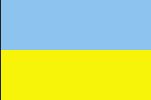 |
NEW: This web page has been translated into Ukrainian by Martha Ruszkowski - August, 2011 Копроліти і скамíяніли вміст кишечника від Смокі Мел Hill |
 |
"Coprolite" is a scientific name for the fossilized excrement, feces or droppings of ancient animals. It was coined by Dr. William Buckland (1829, see below). Hawkins (1834) illustrated several coprolites in his book on ichthyosaurs and plesiosaurs. In the Smoky Hill Chalk Member of the Niobrara Formation, those animals were sharks, teleost (bony) fish and marine reptiles. These fossils can tell us much about what kind of prey these animals ate and how their digestive systems worked. Mudge (1876) and Williston (1898, 1902) were among the first to discuss the presence and origin of coprolites in the Smoky Hill Chalk. See Duffin (2009) for the most recent review of the early literature on coprolites.
Below are several Late Coniacian - Early Santonian coprolites and other gut contents of marine origin from the Smoky Hill Chalk of western Kansas (mostly Gove County). Coprolites are fairly common in the chalk and occasionally may contain partially digested bones (usually fish). Sharks (Cretoxyrhina, Squalicorax and others) are the source of the spiral coprolites, but most of the others are more likely to be from marine reptiles and large fish. Also, it is worth noting here that coprolites are trace fossils, rather than body fossils like most of the fossils pictured and discussed on Oceans of Kansas. A recent publication (Everhart, 2007) reports on the teeth and bones of a pycnodont fish (Micropycnodon kansasensis) recovered from a coprolite. Fossilized gut contents (Miller, 1957; Stewart, 1978) and regurgitated prey material (see Hattin, 1996; Everhart, 1999) are two other categories of unusual biological materials preserved in the chalk.
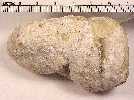 |
A quite large coprolite from the Smoky Hill Chalk shows a very distinct, spiral groove. Although not noticeable in this picture, there are small bits of fish bone embedded in the matrix. (Scale = mm) Here are three other views: One (dark area is a iron pyrite crystal mass); Two; Three; and a Close-up. |
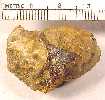 |
A nearly complete but partially digested fish vertebra inside the fragment of a coprolite. The identity of the prey is probably a fish called Cimolichthys. (Scale = mm) |
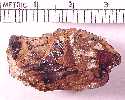 |
Another small coprolite that is completely filled with fish bones. There are two complete vertebrae and one partial vertebra in this coprolite in addition to the bones showing on the surface. The prey species appears to be a small Enchodus. (Scale = mm) |
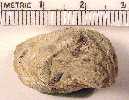 |
A medium sized coprolite filled with what are probably cranial bones of a small fish. (Scale = mm) |
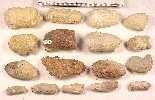 |
An assortment of the usual kinds, shapes and sizes of coprolites collected from the Smoky Hill Chalk Formation. Most are featureless and without identifiable prey remains. While chalky to light brown in color, these coprolites are composed in large part of the remains of digested bone (calcium phosphate), and do not react to acetic acid like chalk (calcium carbonate fizzes) would. |
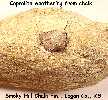 |
A coprolite discovered weathering from the chalk (Logan County, late Santonian in age). Mopt coprolites are more resistant to erosion than the matrix surrounding them. The coprolite is filled with small fish vertebrae. (Scale in mm) |
 |
Three views of a single coprolite (about 3 inches in length) which contains fish remains. The cranium of the prey fish appears to be visible in the lower right side of the bottom panel. Vertebrae, ribs, scales and dermal bones of the skull are visible on the surface of the coprolite. |
 |
This pair of Enchodus palatine bones, minus one fang and part of another, was almost a coprolite, but the Cimolichthys which it was discovered inside apparently died before the bones could be passed from the gut. In this case, a 1.2 meter Cimolichthys had swallowed a smaller (.5 m) Enchodus head first. For some reason, the larger fish died before the prey was digested. It appears that the heavy, indigestible bones of the Enchodus skull, including the long sharp fangs are passed through the gut first. One of those fangs may have pierced something vital in the Cimolichthys and caused it's death. A field photograph (EPC 1994-27, Scale = 15 cm / 6 inches) of this "fish in a fish" is shown HERE. (large dark area was a mass of roots that had invaded the Enchodus skull ).The stratigraphy of the dig site is shown HERE (Late Coniacian). Paired Enchodus palatine and / or lower jaw bones (remains of coprolites??) are collected fairly commonly in the chalk: (One), (Two), (Three), (Four- Dentary and palatine). |
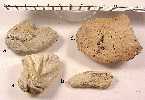 |
Several coprolites and a possible cast of a fish's gut: A) Showing fish bones (ribs?) on the surface; B) an oddly shaped 'coprolite', possibly a gut cast and not a coprolite - (see below for more pictures); C) a coprolite that was split open when discovered, revealing small fish bones inside ; and D) a smaller coprolite with fish bones visible on the surface. (Scale = mm) |
 |
Here are additional pictures of the 'gut cast' (above): One; Two; Three; and Four (end view). (Scale = mm) |
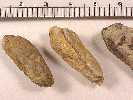 |
Three examples of spiral coprolites from the Niobrara chalk (see Stewart, 1978, for a description). (Scale = mm) |
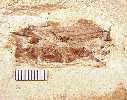 |
An example of a Smoky Hill Chalk coprolite discovered in situ. In this case, the coprolite was weathering faster than the surrounding chalk, and would have been destroyed fairly rapidly. Three relatively large fish vertebrae (Enchodus) are visible. (Scale = mm) |
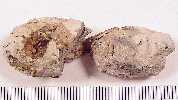 |
A large coprolite that had been broken open by weathering. The coprolite is full of fish bones, including a large vertebra. (Scale = mm) |
 |
This is the largest coprolite that I have ever discovered in the Smoky Hill Chalk. Collected on June 1, 2003, this one measures over 4 inches long and has a maximum diameter of about 2 inches. There are a few tiny bits of bone visible. I suspect this is a mosasaur coprolite. (Early Santonian in age) |
 |
This smaller coprolite is full of what appear to be relatively undigested fish vertebrae and fin rays/ribs (probably Enchodus). Also collected June 1, 2003, Smoky Hill Chalk (Early Santonian), Lane County, Kansas. |
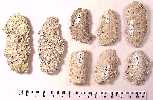 |
Are these coprolites?? Go HERE and judge for yourself..... Oyster shell structures from the Smoky Hill Chalk Formation. |
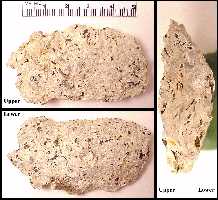 |
OYSTER SHELL COPROLITES:
Typically, these shell masses are shaped as elongate, flattened ovals. The structures average 42 mm in length by 26 mm in width and are usually less than 10 mm thick at the center. Generally, the shell masses are discovered lying on the surface of the chalk where they have weathered out. Typically, they are completely eroded from the chalk, and do not appear to be connected with other fossilized material. The lower side is always smooth and convex, with longitudinal striations on about 25% of those examined. The upper surface is rough (eroded?) in texture and is composed of a compacted mass of randomly arranged, sharp edged shell fragments. No preferential sorting of the fragments has been noted (Everhart and Everhart, 1992). LEFT: Upper and lower views, and a cross-section of a fairly typical oyster shell structure (30 mm x 51 mm - 10 mm thick). Click her for a larger version of the cross-section. |
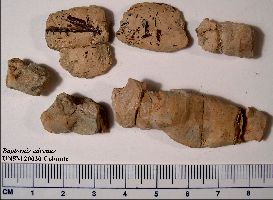 |
LEFT: "Colonites" from a marine bird, Baptornis advenus. "Included with UNSM 20030 are eight coprolites, two of which show small fish jaw and other bones. Most are round or elliptical in cross-section and are elongate, except for the two containing fish material. None shows spiral grooving or surface impressions. George Sternberg, the collector, in a 1937 communication preserved in the records of the University of Nebraska State Museum [UNSM], makes the following reference to the association of these coprolites with Baptornis skeleton: "There are 7 or 8 coprolites ... 2 show small fish bones. These are small compared to the other coprolites I have seen and were found mingled with the bones." It seems likely that these coprolites are correctly associated with the Baptornis skeleton; if so, they are the only ones known for a Cretaceous bird. However, several of them fit together to for a long rounded structure that might be better interpreted as an intestinal cast. The jaw in one coprolite [upper left /RIGHT] was identified by Orville W. Bonner of the University of Kansas (pers. comm., 1972) as Enchodus cf. parvus." (Martin and Tate, 1976, Fig. 22) | 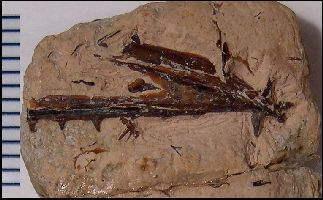 |
COPROLITES FROM OTHER TIMES AND PLACES
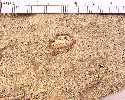 |
This probable coprolite is still in the sandstone matrix in which it was collected. A close-up gives a little more detail but doesn't show that the coprolite is packed with small fragments of fish bone. This specimen comes from the Turner Sandy Member (Shark's Tooth Conglomerate) of the Carlile Shale (Turonian) in southwestern South Dakota. Other fossils collected at the same locality include the ammonite Prionocyclus wyomingensis (steinkerns); the sharks Cretodus sp. and Squalicorax falcatus; the shell crushing shark, Ptychodus whipplei; and many isolated palatine fangs from teleost fish, Enchodus. |
 |
Tiny fish coprolites from the Blue Hill Shale Member (Middle Turonian) of the Carlile Shale, Jewell County, KS. Some of these coprolites include scales and bone fragments. |
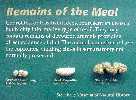 |
A coprolite display at the Sternberg Museum of Natural History in Hays, Kansas. |
Probably the earliest mention of coprolites in an American scientific journal was by J.E. DeKay in 1830 (pages 140-141):
"3. Of the Coprolite: The learned and indefatigable Professor Buckland, in a Memoir recently read before the Geological Society of London, has communicated several curious facts in relation to the fśces of terrestrial and aquatic carnivorous animals, which he has found in a fossil state. They occur in formations of all ages from the carboniferous limestone to the diluvium. The names Ichthyo-copros, Sauro-copros, Hyaino-copros, have been assigned to the excrements of fish, saurians, and the hyśna. To other fossils long supposed to be petrified, and called cones of fir, Professor Buckland assigns the name of Copros iuloÔdes, and from analogy supposes them to be derived from the ray and shark. All these fossil fśces are to be distinguished by the name of Coprolite. In the Cabinet of the Lyceum a specimen of Coprolite from Monmouth county is preserved, which has long attracted our attention, and we are indebted to one of our associates, Mr. I. Cozzens, for a suggestion which enabled us to ascertain its real nature. It is figured plate III. fig. 6, of the natural size.
It is composed of the same convoluted spiral structure attributed to the Sauro-copros, and the marks of pressure on the superior part show it to have been the nucleus of a much larger substance. On the external surface the impressions left by the membranous coat of the intestines are clearly discernible. The length of this specimen is nearly one inch, its substance is homogeneous, black, and it effervesces freely with acids. A small cavity on one side, where was probably undigested matter, is now by a few experiments ascertained to contain carbonate and phosphate of lime, with minute siliceous pebbles. Professor Torrey proposes to furnish the Lyceum with a complete analysis of this very remarkable substance."
In 1834 (p. 32) Dr. Samuel G. Morton wrote in regard to remains discovered in the Cretaceous blue marl in Monmouth County, New Jersey, "Masses which appear to be Coprolites are not unfrequent."
One of the first notes of coprolites in Kansas comes from Prof. Benjamin Mudge (1876, page 217), the first State Geologist of Kansas:
"Coprolites of fish and Saurians are frequently found, containing the remains of the food of the animal. Small fish appear to be the most common food; but in one instance a rare crustacean was found preserved this way. The coprolites are not so hard as those of Europe, being a little firmer than chalk, and finer grained. ........... In some cases the undigested organic material (bones) was one-fourth the whole weight."
Samuel Williston (1891) noted in regards to a Pteranodon specimen that:
"several coprolites found within the above described pelvis, ellipsoidal in shape, and about the size of an almond, showed bones so finely comminuted that their precise character could not be made out."
Samuel Williston (1898, page 214) also mentioned coprolites in his paper on mosasaurs:
"Coprolites which I have always had reason to believe were from these animals are in some places very abundant, weighing from an ounce or two up to a half a pound or more. They are ovoidal in shape with sphincter or intestinal impressions upon them, and contain very comminuted parts of fish bones, fish scales, etc."
Also from S. W. Williston in 1902:
".....Coprolites, evidently of mosasaurs, are frequently found, with large, undigested fish bones, and fragments of fish bones, ...."
From Larry Martin and James Tate, Jr., 1976:
"Included with UNSM 20030 [a specimen of the Late Cretaceous hesperornithid, Baptornis advenus from the upper Smoky Hill Chalk] are eight coprolites, two of which show small fish jaw and other bones. Most are round or elliptical in cross-section and are elongate, except for the two containing fish material. None shows spiral grooving or surface impressions. George Sternberg, the collector, in a 1937 communication preserved in the records of the University of Nebraska State Museum [UNSM], makes the following reference to the association of these coprolites with Baptornis skeleton: "There are 7 or 8 coprolites ... 2 show small fish bones. These are small compared to the other coprolites I have seen and were found mingled with the bones." It seems likely that these coprolites are correctly associated with the Baptornis skeleton; if so, they are the only ones known for a Cretaceous bird. However, several of them fit together to for a long rounded structure that might be better interpreted as an intestinal cast. The jaw in one coprolite was identified by Orville W. Bonner of the University of Kansas (pers. comm., 1972) as Enchodus cf. parvus."
From J. D. Stewart, 1990 (page 22):
"Spiral coprolites, argued to be enterospirae by Stewart (1978), occur in this horizon. McAllister (1985) has conclusively demonstrated that such structures can be found in the colon of dissected Scyliorhinus canicula. Presumably, they can also be expelled intact from the rectum. Their presence in this horizon [zone of Spinaptychus n. sp.] and absence in the other horizons implies the presence of some heretofore undetected shark taxon in this zone. Other types of coprolites occur in all horizons of the Smoky Hill Chalk Member."
REFERENCES:
Buckland, W. 1829. On the discovery of a new species of pterodactyle; and also of the faeces of the Ichthyosaurus; and of a black substance resembling sepia, or Indian ink, in the Lias at Lyme Regis. Proceedings of the Geological Society of London I:96-98.
Buckland, W. 1830. Letter from the Rev. Dr. W. Buckland, F. R. S. &c. Professor of Mineralogy and Geology in the University of Oxford, on the discovery of coprolites in North America. Philosophical Magazine, n.s. 7(41):321-323, 1 text fig. (for May; see also DeKay 1830)
Chin, K. 1999. Exceptional soft-tissue preservation in a theropod coprolite from the Upper Cretaceous Dinosaur Park Formation of Alberta. Journal of Vertebrate Paleontology 19(suppl. to 3): 37A.
DeKay, J.F. 1830. On the remains of extinct reptiles of the genera Mosasaurus and Geosaurus found in the secondary formation of New Jersey; and on the occurrence of a substance recently named coprolite by Dr. Buckland, in the same locality. Annals of the Lyceum of Natural History of New York, 3:134-141.
Duffin, C.J. 2009. "Records of warfare; embalmed in the everlasting hills": A history of early coprolite research. Mercian Geologist 17(2):101-111.
Everhart, M.J. 1999. Evidence of feeding on mosasaurs by the late Cretaceous lamniform shark, Cretoxyrhina mantelli. Journal of Vertebrate Paleontology 17(suppl. to 3):43A-44A. (See this abstract and related publications here)
Everhart, M
.J. 2005. Oceans of Kansas - A Natural History of the Western Interior Sea. Indiana University Press, 322 pp.Everhart, M.J. 2007. Remains of a pycnodont fish (Actinopterygii: Pycnodontiformes) in a coprolite; An upper record of Micropycnodon kansasensis in the Smoky Hill Chalk, western Kansas. Kansas Academy of Science, Transactions 110(1/2):35-43.
Everhart, M.J. and Everhart, P.A. 1992. Oyster-shell concentrations; a stratigraphic marker in the Smoky Hill Chalk (upper Cretaceous) of western Kansas. Kansas Academy of Science, Transactions (Abstracts) 11:12.
Hawkins, T. 1834. Memoirs of Ichthyosauri and Plesiosauri, extinct monsters of the ancient Earth. Relfe and Fletcher, London. 58 p., 28 pls. [See Richard Forrest's version of this paper on the web - coprolites are illustrated]
Hattin, D.E. 1996. Fossilized regurgitate from Smoky Hill Chalk Member of Niobrara Chalk (Upper Cretaceous) of Kansas, USA. Cretaceous Research 17:443-450.
Martin, J.E. 1982. Coprolites from the Pierre Shale in South Dakota. Proceedings of the South Dakota Academy of Science 61:171 (Abstract).
Martin, J.E. Schumacher, B.A., Parris, D.C. and Grandstaff, B.S. 1998. Fossil vertebrates of the Niobrara Formation in South Dakota. Dakoterra 5:39-54.
Martin, L. D. and Tate, J. Jr. 1976. The skeleton of Baptornis advenus (Aves: Hesperornithiformes). Smithsonian Contributions to Paleobiology 27:35-66.
McAllister, J. A., 1985. Reevaluation of the formation of spiral coprolites - University of Kansas Paleontological Contributions. Paper 114, 12 p.
Miller, H.W. 1957. Intestinal casts in Pachyrhizodus, an Elopid fish, from the Niobrara Formation of Kansas. Kansas Academy of Science, Transactions 60(4):399-401.
Morton, S.G. 1834. Synopsis of the organic remains of the Cretaceous group of the United States. Key and Biddle, Philadelphia, 88 pp., 19 pl.
Mudge, B.F. 1876. Notes on the Tertiary and Cretaceous periods of Kansas. Bulletin of the U.S. Geological. Survey of the Territories (Hayden), 2(3):211-221.
Schšfer, W. 1972. Ecology and Palaeoecology of Marine Environments. C. Y. Craig, Ed. The University of Chicago Press, 568 pp.
Schultze, H.-P., Stewart, J.D., Neuner, A.M. and Coldiron, R.W. 1982. Type and figured specimens of fossil vertebrates in the collection of the University of Kansas Museum of Natural History. Part I. Fossil fishes. Miscellaneous Publications, University of Kansas Museum of Natural History 73:53pp. (see pages 16-17 for coprolites in the KU collection)
Seilacher, A., Marshall, C., Skinner, H.C.W. and Tsuihiji, T. 2001. A fresh look at sideritic "coprolites'. Paleobiology 27(1):7-13.
Shimada, K. 1997. Shark-tooth-bearing coprolite from the Carlile Shale (upper Cretaceous), Ellis County, Kansas. Kansas Academy of Science, Transactions 100(3-4):133-138.
Stewart, J.D. 1978. Enterospirae (fossil intestines) from the upper Cretaceous Niobrara Formation of western Kansas. University of Kansas Paleontological Contributions 89:9-16.
Stewart, J.D. 1990. Niobrara Formation vertebrate stratigraphy. pp. 19-30 in Bennett, S. C. (ed.), Niobrara Chalk Excursion Guidebook, The University of Kansas Museum of Natural History and the Kansas Geological Survey.
Stewart, J.D. and Carpenter, K. 1990. Examples of vertebrate predation on cephalopods in the late Cretaceous of the Western Interior. pp. 203-206 in Boucot, A. J. (ed.), Evolutionary paleobiology of behavior and coevolution. Elsevier, New York, 750 pp.
Williams, M.E. 1972. The origin of "spiral coprolites". University of Kansas Paleontological Contributions 59:1-19, 8 pl. (excellent history of coprolites; see also McAllister, 1985)
Williston, S.W. 1891. The skull and hind extremity of Pteranodon. American Naturalist 25(300):1124-1126.
Williston, S.W. 1898. Mosasaurs. The University Geological Survey of Kansas, Volume IV, Paleontology, Part V, pp. 81-347, pls. 10-72.
Williston, S.W. 1902. On certain homoplastic characters in aquatic air-breathing vertebrates, Kansas University Science Bulletin 1(9):259-266.
Credits: Thanks to Earl Manning for a critical review of this page and for providing the DeKay (1830) and Mudge (1876) papers.)
